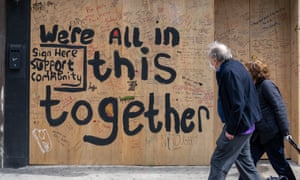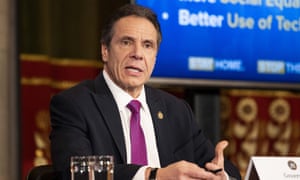States are banding together to fend for themselves, raising fears – or hopes – that the federal government’s grip will be lessened
- Coronavirus – live US updates
- Live global updates
- See all our coronavirus coverage

Photograph: David Dee Delgado/Getty Images
Groups of American states have banded together to form regional partnerships to battle the coronavirus pandemic. The new unions, which now encompass 17 states, have potentially far reaching implications for how the US handles the virus and deals with Donald Trump’s administration in the process.
California, Oregon and Washington have formed the Western States Pact. Seven east coast states, stretching from Delaware to Massachusetts, have formed another alliance. And seven mostly midwestern states – encompassing a vast region that includes Minnesota, Ohio and Kentucky – have created a third group.
The development has even raised fears – or hopes – that the federal government’s grip on America’s states will be loosened, perhaps threatening the union itself. Minnesota’s governor, Tim Walz, likened his midwestern alliance to “sort of a loose Articles of Confederation approach.” California’s governor, Gavin Newsom, has even referred to his state as a “nation state”.
The groups coalesced quickly and organically through conversations between states’ governors, who have been trading notes and ideas on how to respond to the pandemic. The motivation was partially in response to a White House that has wavered from taking full responsibility for the US’s response to Covid-19 to saying that state governors are essentially responsible for tackling the pandemic.
Oregon’s governor, Kate Brown, told the Guardian she had been texting with neighboring governors Jay Inslee in Washington and Newsom in California when the idea emerged.
“As I started to think through how difficult it was to intentionally – literally – shutter our economy, I thought that it would be really good, even if we weren’t taking the same steps, that we at least hold hands, that we create a shared framework,” Brown recalled.
Brown texted the two other governors asking them if they were interested in “working on a shared framework for reopening their states’ economies”.
On 13 April, the three governors announced their Western States Pact.
The coordination between the members of the Western States Pact has gone beyond the governors themselves. Brown said their chiefs of staff have been sharing strategy. Their directors of public health have been sharing resources.
“I think we could say we are aligned in the framework. We’re all carving a path, but we’re each taking individual directions in terms of the path,” Brown said.
Similarly, Illinois’ governor, JB Pritzker, had been texting and talking on the phone with his fellow midwestern governors. He had had a conversation with New York’s governor, Andrew Cuomo, where Pritzker suggested “we maybe need to all band together”. In mid-April Pritzker, along with six other governors in the midwest, announced a partnership to reopen the regional economy. The partnership includes both Democratic and Republican governors.
“I think what we’re looking to do is share best ideas first of all,” Pritzker said in an interview. Second, he said, they want to make sure they’re working together as they go through the phases of reopening their states’ economies.
Cuomo and a swath of east coast governors have set up their own “multi-state council” to “to restore the economy and get people back to work”.

The uniting idea behind the pacts is to formulate plans for easing restrictions and lockdown orders once the coronavirus threat dissipates. Those plans so far vary from the Trump administration’s recently released guidelines for easing restrictions.
Other governors have formed informal regional alliances. Maryland’s governor, Larry Hogan; Washington DC’s mayor, Muriel Bowser; and Virginia’s governor, Ralph Northam, hold regular calls. New Hampshire’s governor, Chris Sununu; Maine’s governor, Janet Mills; and Vermont’s governor, Phil Scott, have remained in contact throughout the pandemic, although those states aren’t in the same formal east coast council with New York and others.
Publicly and privately governors have groused that the Trump administration has been frustratingly inconsistent and unhelpful in directing the federal government to fight the pandemic, pushing states to go at it alone or in the groups they have formed.
Jared Leopold, a Democratic strategist and former communications director of the Democratic Governors Association, said the alliances were partially a result of a lack of national leadership.
“Nature abhors a vacuum and with a vacuum of national leadership on the coronavirus crisis, states are having to fend for themselves,” Leopold said. “That means putting together coalitions however they can.”
Alliances among governors aren’t unprecedented in America. Governors have formed an alliance during the Trump presidency to fight the climate crisis. Nor do the partnerships mean the moves by each governor are uniform. Restrictions and executive orders approved by the Michigan governor, Gretchen Whitmer, are not the same as the ones by Ohio’s governor, Mike DeWine.
Pritzker said it made sense that states in the same regions banded together rather than ones far apart.
“My state is a little bit like Michigan in this sense: we have one big city, a very big city. And then we have some very small cities and a lot of agricultural territory in Illinois. Seventy per cent of our landmass is agricultural. And that’s very similar to Indiana and Michigan,” Pritzker said.
“California’s very different. It’s got multiple big cities, many – San Diego, San Francisco, and LA and so on. These are very big cities. So that’s a different way of thinking than what we would need to do here. So that’s some of the reason that these regional pacts work. We share a lot of similarities from state to state.”
There are ongoing differences in the regional responses to the pandemic as well. A few southern states – Georgia, Tennessee and South Carolina – have been much more eager to loosen restrictions than other states across the country. Those states have not set up a formal pact.
Scott Pattison, a former executive director of the National Governors Association, expects that the states in the regional pacts will work together closely as they move forward.
“I’m anticipating that they really do follow through,” Pattison said. “That Washington state won’t necessarily take substantive measures without consulting with Oregon and California – both for this moment but also to hopefully to create some precedence for effective groupings for the future.”
Source: US Politics - theguardian.com



